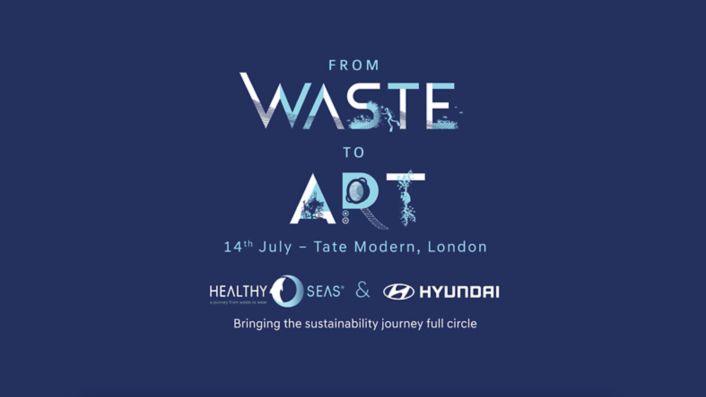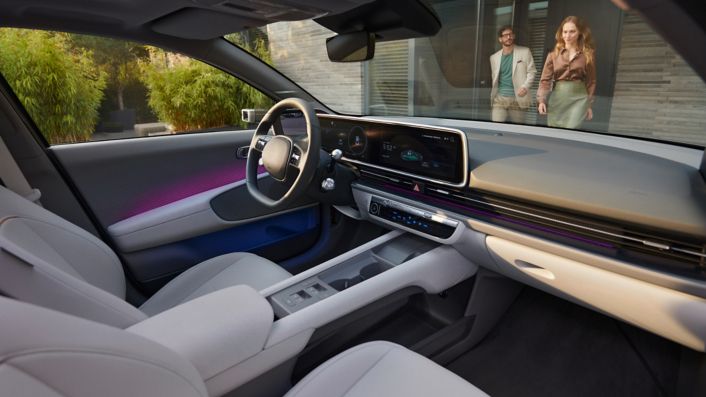Hyundai announced its partnership with Healthy Seas in 2021 as a way of fostering a more sustainable future.
With Hyundai’s commitment to developing emission-free mobility solutions, and Healthy Seas’ expertise in protecting marine ecosystems, the two organisations hold a shared vision for shaping sustainable communities and making the world a better place for future generations.

Hyundai and Healthy Seas’ mission to clean up | BBC Storyworks
The ocean is increasingly filling with plastic waste.
The Healthy Seas foundation, in co-operation with major partners like Hyundai Motor Company, is on a mission to clean up “ghost gear” while raising awareness about protecting the ocean environment.
When we arrived, we saw big white rocks along the shoreline. But drawing closer, we realised they were styrofoam blocks. When we stepped on them, we began to sink into waste up to our knees. It smelled toxic – so toxic that butterflies were drawn to it because it smelled so sweet. Ants had started to build their nests in the waste. It was a big mess.

Veronika Mikos
Collaboration
Arriving on the island of Ithaca, Greece, Mikos hadn’t been prepared for the sheer scale of the challenge Healthy Seas faced. A beach strewn with discarded litter, old fishing nets, and rubbish that had floated ashore – a gargantuan task to clean up.
And under the ocean’s surface lie “ghost farms”, where fish farming debris, like nets, buckets, lines and traps, are left in the sea along kilometres and kilometres of coastlines.
Locals reached out to Healthy Seas; a foundation committed to cleaning up marine pollution as well as raising awareness on ocean health. In 2021, Mikos and a crack team from Healthy Seas teamed up with Hyundai to co-ordinate the big Ithaca clean-up, repurposing waste fishing nets from the sea to produce material for Hyundai floor mats.
Ghost farms are significantly worse than floating nets because of the sheer size.
The scale of ocean garbage
Education is an important piece of the puzzle, as it’s critical that people understand the role each and every one of us play when it comes to protecting the oceans.
Since 2021, Hyundai has supported the activities of Healthy Seas, which include not only significant ocean cleanups but also running educational programmes and community engagement to future-proof the ocean. Over the past couple of years, Hyundai and Healthy Seas have focused on cleaning up three abandoned fish farms in Greece. Divers and surface volunteers retrieved 170.7 tonnes of waste from these sites –some 35% of which was abandoned nets.
Making use of ghost gear
Once Healthy Seas has fished waste out of the sea, there remains the question of what to do with it.
Aquafil, a textiles company specialising in regenerated nylon, was one of Healthy Sea’s founding partners in 2013. Aquafil has been a pioneer of the circular economy for textiles by leading in the use of regenerated nylon, a fibre that can be recycled indefinitely.
The nylon waste, suitable for recycling, fished out of the ocean by Healthy Seas heads to Aquafil’s warehouses in Slovenia. Aquafil then uses the synthetic nylon from discarded fishing nets and other waste materials to create regenerated nylon. What makes these fibres special, says Maria Giovanna Sandrini, chief communications officer at Aquafil, is they can be recycled indefinitely without being destroyed:
We’ve changed the manufacturing process from a linear to a circular one.

Giovanna Sandrini
Ghost gear, in short, is returned to life. Hyundai invests in removing waste from the ocean, some of which is processed by Aquafil. The material is then made into usable mats that fit snugly into some of Hyundai’s cars.


The bigger picture
Currently, the transportation sector contributes to 20% of global carbon emissions - of which over 70% comes from road traffic.
Aware of the urgency to address its own environmental impact, Hyundai has set goals to start this process which includes reducing its greenhouse gas emissions and, guided by global EV policy mandates, is investing in electrification and hydrogen technology.
Another focus for Hyundai is to establish a circular economy ecosystem in areas such as its design process. Diana Kloster, head of colour, material and finishing team (CMF) at the Hyundai HQ in Korea, sees sustainability as a key element in redesigning products and rethinking current production systems for future generations.
We have the possibility not just to design products, but also to design the future. We are free to explore and create the best possible items in a way that’s supportive of biodiversity for nature, in harmony with it – not against it. We need to consider what parts of our product are made of, the option of reassembly, where it is going later, or can go. Maybe it feels small, but this consistent progress will allow us to reach ambitious targets and prove reliability to our customers.

Diana Kloster
The floor mats in Hyundai’s electric vehicles sold in Europe are now made of ECONYL, a fully recycled nylon yarn made by Aquafil out of recovered fishing nets, among other nylon waste. And this is only one small example as Hyundai aims to further enhance the use of recycled and renewable materials in its new EV models globally.
For example, in the IONIQ 5, recycled PET processed yarn is used in the armrests and seat coverings, equivalent to the recycling of up to 32 PET bottles per vehicle. Meanwhile, the fabric materials used for the seats, headliner, and carpeting include bio-based components derived from sugarcane and corn. The doors are also made from 100% renewable paperette, while the paint applied to the doors and crash pad is a bio-paint derived from plants such as rapeseed and corn. Kloster explains why the company is giving such a strong focus to recycled materials in the cars:
In the coming years circular design practices, renewable power and materials will transform interiors and the industry. The decision for a circular business model is a decision to protect the environment, society and economy.
Education as a solution
While cleaning up the oceans and reducing waste is important, prevention is better than cure.
A significant part of the work done by Healthy Seas and Hyundai is to educate both young and old across the 20 countries in which the foundations work, including those in the Baltics and around the Red Sea.
Our goal for education is to promote ocean literacy among children and adults. We involve young and older people because we want everyone to understand the interconnectedness of both people and oceans. Big gaps in science and geography need to be filled, and that’s where we come in.
Healthy Seas prioritises showing rather than telling as part of their educational programme. The programmes focus on children aged 6-18, taking place along coastlines or online. Partnering with the European Outdoor Education Hub, Healthy Seas runs outdoor experience sessions to address concerns around marine litter and environmental destruction.
We need to make sure people understand what’s happening under the water. I think most would find it unbelievable. So, alongside our partners, we play a learning piece and it’s a big role. Collaborating and promoting education about the oceans for future generations, forms a big part of the clean-up puzzle, which will continue for decades to come. Every industry, no matter how big or small, needs partnerships like Hyundai has with Healthy Seas. And everything, after its lifetime, should become a material for something else. It comes full circle.






